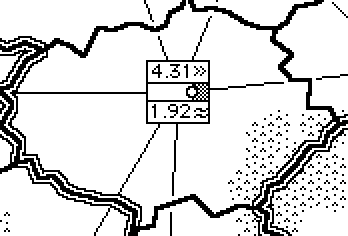Combat
| The combat system I designed for Guns & Butter was also quite innovative. My scheme made the military power in each province a continuous variable (as opposed to the discrete military units used in conventional combat systems). In other words, the player could have 4.2 "bangs" of military power in one province and 2.73 "bangs" of military power in another province. During each turn, the player specified just two commands to the armies in each of his provinces:
If the player directed his mobile armies to move to an adjacent friendly province, they would reinforce the defenses there. If instead he directed his mobile armies to move into an unfriendly province, they would then attack that province. These commands were clean and simple to implement. To specify the portion of the army moving and the portion of the army staying, the player merely slid a small dot right or left in the military allocation box, which looked rather like what appears in Figure 24.8. 24.8. Military allocation box.
Specifying the direction of attack required nothing more than clicking on the chosen province, dragging to the destination province, and then releasing the mouse button. When combat was initiated, the player was treated to a dramatic display showing big black arrows sweeping across the map, representing the attacks of the various armies. When combat was resolved, the attacking player, if successful, would find his mobile army now established in the capital of the newly-conquered province, and the map redrawn to show the new country borders. The military strategy of the game was its best feature. The strategies available to the player were simple to imagine but intricate in their possible interactions. A player could attack one province from several directions, in which case the attacks would play out in sequence. The first attack might only weaken the defenders, but then a second or third might be successful. To counter this, the defender could launch an attack at the attacker's jumping-off province in the hopes that, stripped of its army, he might obtain an easy victory. Of course, the attacker could counter this by moving reserves from an uninvolved province into the jumping-off province. As you can see, the possible combinations were endless, and provided the player with some fascinating challenges. The alliance system of the game, on the other hand, was a complete muddle. One of the players would declare an alliance against some enemy, and then try to induce other players to join the alliance. Such an alliance pooled their economic resources, making possible much more efficient and productive economies. I thought that these alliances, being so powerful, would provide lots of ups and downs in the game, as alliances would constantly shift in response to the successes and failures of the different players. In practice, it just didn't work. I put a great deal of effort into this subsystem of the game, and it included many devious and clever algorithms. For example, players could betray each other by breaking off an alliance and forming a new alliance with the enemy. When this happened, the betrayed player developed a distrust of the traitor, which would inhibit any predilections to forming a later alliance with him. In the end, however, alliances simply didn't work out as well as I had hoped. Early in the game, the alliances would work well, but as the game progressed and players betrayed each other, the overall level of distrust built up so high that nobody would trust anybody enough to form an alliance; at that point, the game was won by the biggest brute in the world. |
EAN: 2147483647
Pages: 248
